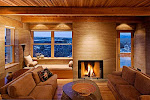I shoot a fair amount of homes by custom builders to fill in the gaps between big commercial jobs. The budgets are low so I need to work quickly. I have to squeeze a decent set of shots out of a limited time even if the light is not primo. Here is an example of an HDR that to me works (a little surreal I admit). The day was bright overcast. The sun was high and above left. The area under the porch was too dark. If I exposed for the porch the sky blew out. A pain to try and light the porch. Three exposures-2 stop range. Exposure Blend in Photomatix. HDR always needs some additional adjustments in PS after the blend, because the midtones tend to get a little flat and lifeless. I like Tony Kuyper's Luminoscity Masks for this. HDR is just another tool if used appropriately.
Show some of your examples.
Before

After

Client comments-the contractor loved the HDR because you could see all the rich detail under the roof. He thought it "really came alive". To satisfy him any other way would mean I would have had to light it. It also ran full page in an article in a homebuilder magazine. The editor, my primary client, thought it was a bit "surreal" and didn't like it that much but ran it, but I didn't hear that until after it ran. It could be toned down slightly and still be effective. Personally I like the HDR (I grant you a bit tooooomuch maybe). The straight image just sits there, muddy and lifeless.













Hard to satisfy different kinds of clients, huh? Would something in between perhaps have satisfied both? Or, could you have done the second version for the contractor and a blend of the two for the magazine?
ReplyDeleteI do kind of agree that the second version doesn't look quite natural, since there is no apparent source for the "lighting" under the overhang, and no shadows to suggest a strong light source coming from the side or below.
I agree that there's a fine line between the surreal and the perfectly blended "HDR" shot... I have to try Photomatrix, but so far I've found that I still get the most realistic results by blending my exposures by hand in good ol' photoshop.
ReplyDeleteI wrote a blog post about this as well, if you're curious:
http://merrittdesignphoto.blogspot.com/2009/11/architectural-photography-capture.html
Love your work, by the way!
Cheers!
Jennifer
In all truth, the over lit style of American APs has never been truthful. While we tried to make lighting believable, the overriding ethic was to make it sexy and there was never a way to explain where our lights were coming from. In Europe it has always been different, relying primarily on time of day and existing light. So,in a way, HDR is not much different than what American Aps have always been doing. Having said that, I am always interested in true natural light when it works for me. the question is what do you do when you are up against a time crunch (weather, budget etc.) and you HAVE to make it work for you.
ReplyDeleteThe whole HDR debate is rather baffling to me. Does it really matter how we achieve our images?
ReplyDeleteBesides, no camera works like the human eye does anyhow. Photographers have been compressing dynamic range since the beginning by dodging & burning in the darkroom and chemists have worked to develop films that have variable sensitivity.
Let's admit it: One of the biggest complements we get as photogaphers is "You make it look better than it really is!". This is why our clients hire us, and HDR is just another tool we can use to please our clients.
Us panorama guys have embraced HDR. Many of the spherical panoramic scenes we shoot cannot be adequately captured with just one exposure setting. The new HDR tools produce halo-free images that look realistic and pleasing.
Here's an HDR scene shot with a Canon 5d2/15mm fisheye. 6 around + 1 nadir, 3 exposures bracketed at 1/3, 1.6, and 6 sec. F3.5, ISO 800: http://www.panaviz.com/exterior-hotel/
(Right click and choose "architectural projection" for you architectural photographers ;-)
"Let's admit it: One of the biggest complements we get as photogaphers is "You make it look better than it really is!". This is why our clients hire us, and HDR is just another tool we can use to please our clients."
ReplyDeleteAbsolutely true.
I am curious when the act of correctly balancing an image became tolerable HDR? I always assumed there were going to be corrections in contrast and tonality in a print due to the differences between media capture and what we see with our own eye. In my experience rarely does a image print without modification unless the lighting is accurately represented in media at capture. The question then is this HDR, has this treatment historically considered as HDR but not referenced as such, or is this simply what a print requires in order to be considered a professional rendering? Most of the "HDR" I have seen tends to create a caricature of the scene. Can HDR be rendered using standard contrast balancing techniques rather than a HDR tool? Is it still HDR?
ReplyDeleteJet,
ReplyDeleteHDR became a buzz work a couple of years ago with the over-the-top use of programs like PhotoMatix Pro. Before that we called it...what burning and dodging, balancing the shadows and highlights?
I think here we are all working towards the same thing, a believable tonally compressed image from a high dynamic range scene. There are many ways too get there, with film by over exposing and under developing (or semi-stand development), by using an HDR program on digital images or manually combining two exposures in PS.
Jet, its not about what it is called, it is about the product. Personally I stay away from referring to the term HDR with clients in case they are aware of the anti-HDR backlash that is currently going on.